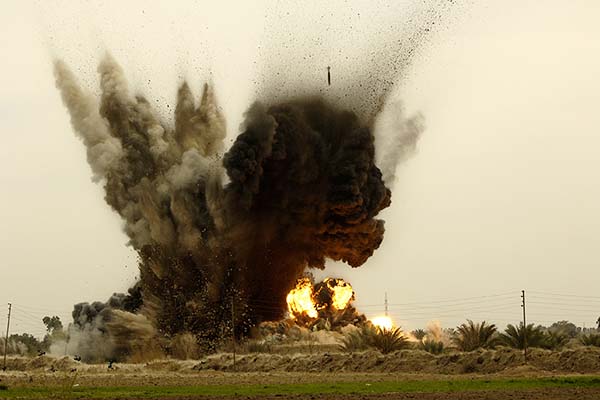
File Photo
Experts warns U.S. military’s decision to target Taliban drug-labs risk alienating local population
As the U.S. military opens a new front in its air war in Afghanistan, targeting the Taliban’s poppy-processing factories and dropping thousands more bombs, experts are warning of the risk of alienating the local population.
The quickening tempo comes after President Donald Trump in August approved broad new powers for General John Nicholson, who commands U.S. and NATO forces in Afghanistan. Numbers reveal a massive uptick in airstrikes already, with the U.S. military on course to triple the number of bombs it has dropped this year.
As of Oct. 31, the U.S. had released 3,554 weapons in Afghanistan, compared to 1,337 for all of 2016, when the war was overseen by then president Barack Obama. Trump’s new rules mean America can now proactively bomb the Taliban, where before strikes were restricted to backing up Afghan partners on the ground.
Nicholson on Monday announced a series of strikes on at least 10 labs used to process opium into heroin, dealing a blow to a key source of Taliban funding. Huge B-52 bombers and F-22 Raptor stealth fighters destroyed the facilities in rural Helmand, marking the first time F-22s had been used in Afghanistan.
The Air Force has a growing stash of high-tech planes and drones at its disposal as operations against the Islamic State group in Syria and Iraq wind down.
America often boasts that its bomb-dropping technologies are the most precise in history. But Andrea Prasow, deputy Washington Director at Human Rights Watch, said an increase in airstrikes would likely lead to more civilian deaths and that, in turn, risks alienating the Afghans.
“The Trump administration has been clear it doesn’t want to do so-called ‘nation building,’ but if the primary focus is on military engagement then the U.S. will be creating enemies where it should be creating friends,” she told AFP.
An increase in civilian harm also could anger the international community, with many NATO nations already weary of Afghanistan commitments after 16 years of war. In 2009, a German NATO commander called in an airstrike in the northern city of Kunduz, with U.S. planes hitting two fuel tankers stolen by the Taliban, killing about 100 people, including many civilians. The fallout from the bombing led to a backlash among German voters. And in 2015 a U.S. airstrike during fighting hit a Kunduz hospital operated by Medecins Sans Frontieres, killing 42 people and sparking international outrage.
Trump’s new rules mean that aside from more air power, Nicholson also has about 3,000 additional American troops, some of whom will be accompanying Afghans close to the front lines, calling in strikes and potentially seeing combat. “They will be out on more patrols, absolutely,” Pentagon spokesman Lieutenant Colonel Mike Andrews said. “They are out there in harm’s way alongside the Afghans.”
Nicholson thinks 80 percent of the Afghan population can be under government control within about two years, up from less than two-thirds today. He sees 2018 as a potential turning point, and pointed to a doubling of the number of Afghan commandos and a new cadre of supposedly less-corrupt officers as positive indicators for next year.
Already, casualty rates among Afghan security forces have started to drop, Nicholson said, but it is hard to verify the claim because Washington has agreed to classify data on the casualty numbers. Time will tell whether Nicholson can succeed, but if history is a guide he has a difficult task ahead.
Obama in late 2009 announced a 30,000-troop “surge” that brought the U.S. contingent in Afghanistan to nearly 100,000 troops along with almost 50,000 allied troops. Many of the gains, including against the Taliban’s drug industry, were quickly eroded after Western forces drew down.
Nicholson said the withdrawal was “too far and too fast” and showed the Taliban that America had “lost our will.” Currently about 14,000 U.S. troops are in Afghanistan.
Like a string of leaders before him, Nicholson said it was time for the Taliban to lay down their arms and enter into a reconciliation process. “If they don’t, they’re going to be consigned to irrelevance … or death,” he said.
For John Hannah, senior counselor for the Foundation for Defense of Democracies and former national security adviser to vice president Dick Cheney, going after the Taliban’s narcotics empire is essential. “Any strategy that hopes to succeed must include a major effort to attack the enemy’s most important revenue streams,” he told AFP, noting that U.S. commanders have drawn lessons from the success of striking Islamic State oil facilities and cash warehouses in Syria and Iraq.
Hannah warned that “without question” the uptick in bombing would result in greater civilian casualties. “But if reinforced by all the other elements of the administration’s new strategy, a sustained escalation of U.S. air support could put the Afghan army back on the offensive and, over time, start to reverse the tide of the war,” he said.
